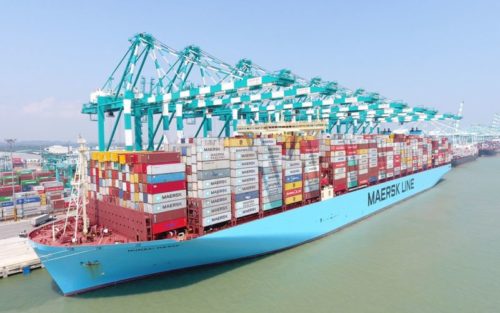
Despite weak market conditions and slow container growth of 1.4 percent, Danish shipping group, A.P. Moller–Maersk managed to improve earnings and free cash flow in 2019.
The company’s earnings before interest, tax, depreciation, and amortization (EBITDA) were up by 14 percent to USD5.7bn compared to 2018 and the EBITDA margin increased to 14.7 percent. Revenue decreased slightly to USD38.9bn in 2019 from USD 39.3bn.
Free cash flow was USD6.8bn, compared to USD 5.1bn last year and CAPEX declined by USD 1.2bn to USD 2bn in 2019.
“Despite weaker market conditions A. P. Moller–Maersk was able to improve profitability and cash flow. Our cash return was healthy, and we continued the reduction of net interest-bearing debt, leading to a further deleveraging of USD 3.3bn over the year. It gives us a solid starting point for 2020 to further expand our end-to-end offering within container logistics while at the same time managing the market challenges that are obviously out there,” CEO of A.P. Møller – Mærsk A/S, Søren Skou, said.
“While we still need to improve returns, we delivered solid progress in our financial performance in 2019 while progressing the business transformation, in spite of weak trade growth, ongoing trade tensions and geopolitical uncertainty in many markets.”
In Ocean, EBITDA in 2019 increased 15 percent to USD 4.4bn, with revenue at USD 28.4bn amid a small decrease in volumes to 13.3m FFE. Unit cost at fixed bunker decreased by 1.7 percent, mainly due to improvements in capacity management and foreign exchange rate developments.
EBITDA in Logistics & Services saw a 24 percent increase to USD 238 million, while revenue decreased slightly to USD 6bn from USD 6.1bn, driven by a decrease in sea and air freight forwarding activity, which was only partly offset by an increase in warehousing and distribution.
Terminals & Towage reported an increase in EBITDA of 11 percent to USD 1.1bn with a revenue increase of 3.2 percent to USD 3.9bn.
In gateway terminals, EBITDA increased by 17 percent to USD 902m, amid a ramp-up of the new terminal in Moin, Costa Rica, higher volumes, higher storage income and reduction in SG&A.
Maersk said that synergies harvested from the Hamburg Süd acquisition and the integration of transport and logistics reached USD 1.2bn, which is above the expected target.
The long-term target on return on invested capital after tax (ROIC) grew to 3.1 percent in 2019, compared to 0.2 percent the year before.
Q4 took a tumble
In the fourth quarter of 2019, A.P. Møller – Mærsk A/S’ share loss hit USD 72 million, compared to the prior year’s profit of USD 32 million.
Loss from continuing operations in Q4, 2019 reached USD 61 million, compared to a loss of USD 72 million a year ago.
The underlying profit from continuing operations was USD 29 million, down from USD 65 million in 2018.
Revenue fell to USD 9.67 billion from USD 10.24 billion in 2018.
Outlook for 2020
For 2020, Maersk expects an EBITDA of around USD 5.5bn, before restructuring and integration costs. The organic volume growth in Ocean is expected to be in line with or slightly lower than the estimated average market growth of 13 percent for 2020.
“The outlook and guidance for 2020 is subject to significant uncertainties and impacted by the current outbreak of the Coronavirus in China, which has significantly lowered visibility on what to expect in 2020. As factories in China are closed for longer than usual in connection with the Chinese New Year and as a result of the Coronavirus, we expect a weak start to the year,” Maersk said.
“The guidance for 2020 is also subject to uncertainties related to the implementation of IMO 2020 and the impact on bunker fuel prices and freight rates combined with the weaker macroeconomic conditions and other external factors.”
The accumulated guidance on CAPEX for 2020-21 is still USD 34bn. A high cash conversion (cash flow from operations compared to EBITDA) is expected for both years.